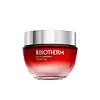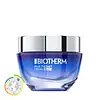What's inside
What's inside
 Key Ingredients
Key Ingredients

 Benefits
Benefits

 Concerns
Concerns

 Ingredients Side-by-side
Ingredients Side-by-side

Water
Skin ConditioningGlycerin
HumectantDimethicone
EmollientRhamnose
HumectantIsohexadecane
EmollientAlcohol Denat.
AntimicrobialPropanediol
SolventIsopropyl Isostearate
EmollientBehenyl Alcohol
EmollientVinyl Dimethicone/Methicone Silsesquioxane Crosspolymer
Cetyl Alcohol
EmollientDimethicone/Vinyl Dimethicone Crosspolymer
Skin ConditioningNylon-12
Alaria Esculenta Extract
Skin ProtectingCarrageenan
Tin Oxide
AbrasivePEG-100 Stearate
Stearic Acid
CleansingSorbitan Oleate
EmulsifyingCarbomer
Emulsion StabilisingCetearyl Alcohol
EmollientCetearyl Glucoside
EmulsifyingCaffeine
Skin ConditioningNeohesperidin Dihydrochalcone
MaskingSodium Chloride
MaskingSodium Lactate
BufferingMyristic Acid
CleansingPalmitic Acid
EmollientPalmitoyl Tetrapeptide-7
Skin ConditioningPalmitoyl Tripeptide-1
Skin ConditioningAdenosine
Skin ConditioningAmmonium Polyacryloyldimethyl Taurate
Emulsion StabilisingDisodium Stearoyl Glutamate
CleansingHydrolyzed Rhodophyceae Extract
Caprylic/Capric Triglyceride
MaskingCaprylyl Glycol
EmollientVitreoscilla Ferment
Skin ConditioningCitric Acid
BufferingTrisodium Ethylenediamine Disuccinate
Xanthan Gum
EmulsifyingSynthetic Fluorphlogopite
Polysorbate 20
EmulsifyingPolysorbate 80
EmulsifyingAcrylamide/Sodium Acryloyldimethyltaurate Copolymer
Emulsion StabilisingButylene Glycol
HumectantPhenoxyethanol
PreservativeCI 77163
Cosmetic ColorantCI 77491
Cosmetic ColorantCI 77891
Cosmetic ColorantMica
Cosmetic ColorantLinalool
PerfumingGeraniol
PerfumingLimonene
PerfumingCitronellol
PerfumingParfum
MaskingWater, Glycerin, Dimethicone, Rhamnose, Isohexadecane, Alcohol Denat., Propanediol, Isopropyl Isostearate, Behenyl Alcohol, Vinyl Dimethicone/Methicone Silsesquioxane Crosspolymer, Cetyl Alcohol, Dimethicone/Vinyl Dimethicone Crosspolymer, Nylon-12, Alaria Esculenta Extract, Carrageenan, Tin Oxide, PEG-100 Stearate, Stearic Acid, Sorbitan Oleate, Carbomer, Cetearyl Alcohol, Cetearyl Glucoside, Caffeine, Neohesperidin Dihydrochalcone, Sodium Chloride, Sodium Lactate, Myristic Acid, Palmitic Acid, Palmitoyl Tetrapeptide-7, Palmitoyl Tripeptide-1, Adenosine, Ammonium Polyacryloyldimethyl Taurate, Disodium Stearoyl Glutamate, Hydrolyzed Rhodophyceae Extract, Caprylic/Capric Triglyceride, Caprylyl Glycol, Vitreoscilla Ferment, Citric Acid, Trisodium Ethylenediamine Disuccinate, Xanthan Gum, Synthetic Fluorphlogopite, Polysorbate 20, Polysorbate 80, Acrylamide/Sodium Acryloyldimethyltaurate Copolymer, Butylene Glycol, Phenoxyethanol, CI 77163, CI 77491, CI 77891, Mica, Linalool, Geraniol, Limonene, Citronellol, Parfum
Water
Skin ConditioningHydrogenated Polyisobutene
EmollientGlycerin
HumectantButylene Glycol
HumectantDimethicone
EmollientCetyl Alcohol
EmollientGlyceryl Stearate
EmollientZea Mays Starch
AbsorbentElaeis Guineensis Oil
EmollientParaffinum Liquidum
EmollientPEG-100 Stearate
Cera Alba
EmollientSorbitol
HumectantMyristyl Myristate
EmollientZea Mays Oil
EmulsifyingPEG-14m
Emulsion StabilisingCera Microcristallina
Emulsion StabilisingParaffin
PerfumingAlgae
Skin ConditioningSorbitan Tristearate
EmulsifyingGlyceryl Acrylate/Acrylic Acid Copolymer
HumectantDimethyl Isosorbide
SolventIsohexadecane
EmollientLaminaria Ochroleuca Extract
Skin ConditioningSodium Hydroxide
BufferingMoringa Oleifera Seed Extract
Skin Conditioning2-Oleamido-1,3-Octadecanediol
Skin ConditioningPhenoxyethanol
PreservativePrunus Armeniaca Kernel Oil
MaskingAdenosine
Skin ConditioningChlorphenesin
AntimicrobialDisodium EDTA
Propylene Glycol
HumectantHydroxypropyl Tetrahydropyrantriol
Skin ConditioningCapryloyl Salicylic Acid
ExfoliatingVitreoscilla Ferment
Skin ConditioningPassiflora Edulis Seed Oil
EmollientXanthan Gum
EmulsifyingMaltitol
HumectantPentaerythrityl Tetra-Di-T-Butyl Hydroxyhydrocinnamate
AntioxidantOctyldodecanol
EmollientAcrylamide/Sodium Acryloyldimethyltaurate Copolymer
Emulsion StabilisingPolysorbate 80
EmulsifyingOryza Sativa Bran Oil
EmollientParfum
MaskingWater, Hydrogenated Polyisobutene, Glycerin, Butylene Glycol, Dimethicone, Cetyl Alcohol, Glyceryl Stearate, Zea Mays Starch, Elaeis Guineensis Oil, Paraffinum Liquidum, PEG-100 Stearate, Cera Alba, Sorbitol, Myristyl Myristate, Zea Mays Oil, PEG-14m, Cera Microcristallina, Paraffin, Algae, Sorbitan Tristearate, Glyceryl Acrylate/Acrylic Acid Copolymer, Dimethyl Isosorbide, Isohexadecane, Laminaria Ochroleuca Extract, Sodium Hydroxide, Moringa Oleifera Seed Extract, 2-Oleamido-1,3-Octadecanediol, Phenoxyethanol, Prunus Armeniaca Kernel Oil, Adenosine, Chlorphenesin, Disodium EDTA, Propylene Glycol, Hydroxypropyl Tetrahydropyrantriol, Capryloyl Salicylic Acid, Vitreoscilla Ferment, Passiflora Edulis Seed Oil, Xanthan Gum, Maltitol, Pentaerythrityl Tetra-Di-T-Butyl Hydroxyhydrocinnamate, Octyldodecanol, Acrylamide/Sodium Acryloyldimethyltaurate Copolymer, Polysorbate 80, Oryza Sativa Bran Oil, Parfum
Ingredients Explained
These ingredients are found in both products.
Ingredients higher up in an ingredient list are typically present in a larger amount.
We don't have a description for Acrylamide/Sodium Acryloyldimethyltaurate Copolymer yet.
Adenosine is in every living organism. It is one of four components in nucleic acids that helps store our DNA.
Adenosine has many benefits when used. These benefits include hydrating the skin, smoothing skin, and reducing wrinkles. Once applied, adenosine increases collagen production. It also helps with improving firmness and tissue repair.
Studies have found adenosine may also help with wound healing.
In skincare products, Adenosine is usually derived from yeast.
Learn more about AdenosineButylene Glycol (or BG) is used within cosmetic products for a few different reasons:
Overall, Butylene Glycol is a safe and well-rounded ingredient that works well with other ingredients.
Though this ingredient works well with most skin types, some people with sensitive skin may experience a reaction such as allergic rashes, closed comedones, or itchiness.
Learn more about Butylene GlycolCetyl Alcohol is a fatty alcohol. Fatty Alcohols are most often used as an emollient or to thicken a product.
Its main roles are:
Though it has "alcohol" in the name, it is not related to denatured alcohol or ethyl alcohol.
The FDA allows products labeled "alcohol-free" to have fatty alcohols.
Learn more about Cetyl AlcoholDimethicone is a type of synthetic silicone created from natural materials such as quartz.
What it does:
Dimethicone comes in different viscosities:
Depending on the viscosity, dimethicone has different properties.
Ingredients lists don't always show which type is used, so we recommend reaching out to the brand if you have questions about the viscosity.
This ingredient is unlikely to cause irritation because it does not get absorbed into skin. However, people with silicone allergies should be careful about using this ingredient.
Note: Dimethicone may contribute to pilling. This is because it is not oil or water soluble, so pilling may occur when layered with products. When mixed with heavy oils in a formula, the outcome is also quite greasy.
Learn more about DimethiconeGlycerin is already naturally found in your skin. It helps moisturize and protect your skin.
A study from 2016 found glycerin to be more effective as a humectant than AHAs and hyaluronic acid.
As a humectant, it helps the skin stay hydrated by pulling moisture to your skin. The low molecular weight of glycerin allows it to pull moisture into the deeper layers of your skin.
Hydrated skin improves your skin barrier; Your skin barrier helps protect against irritants and bacteria.
Glycerin has also been found to have antimicrobial and antiviral properties. Due to these properties, glycerin is often used in wound and burn treatments.
In cosmetics, glycerin is usually derived from plants such as soybean or palm. However, it can also be sourced from animals, such as tallow or animal fat.
This ingredient is organic, colorless, odorless, and non-toxic.
Glycerin is the name for this ingredient in American English. British English uses Glycerol/Glycerine.
Learn more about GlycerinIsohexadecane is added to enhance texture, emulsify, and to help cleanse. It is an isoparrafin. It is a component of petrolatum.
Due to its large size, Isohexadecane is not absorbed by the skin. Instead, it sits on top and acts as an emollient. Emollients help keep your skin soft and smooth by trapping moisture within.
Isohexadecane is often used in products designed to help oily skin. It is lightweight and non-greasy while helping to moisturize. When mixed with silicones, it gives a product a silky feel.
Learn more about IsohexadecaneParfum is a catch-all term for an ingredient or more that is used to give a scent to products.
Also called "fragrance", this ingredient can be a blend of hundreds of chemicals or plant oils. This means every product with "fragrance" or "parfum" in the ingredients list is a different mixture.
For instance, Habanolide is a proprietary trade name for a specific aroma chemical. When used as a fragrance ingredient in cosmetics, most aroma chemicals fall under the broad labeling category of “FRAGRANCE” or “PARFUM” according to EU and US regulations.
The term 'parfum' or 'fragrance' is not regulated in many countries. In many cases, it is up to the brand to define this term.
For instance, many brands choose to label themselves as "fragrance-free" because they are not using synthetic fragrances. However, their products may still contain ingredients such as essential oils that are considered a fragrance by INCI standards.
One example is Calendula flower extract. Calendula is an essential oil that still imparts a scent or 'fragrance'.
Depending on the blend, the ingredients in the mixture can cause allergies and sensitivities on the skin. Some ingredients that are known EU allergens include linalool and citronellol.
Parfum can also be used to mask or cover an unpleasant scent.
The bottom line is: not all fragrances/parfum/ingredients are created equally. If you are worried about fragrances, we recommend taking a closer look at an ingredient. And of course, we always recommend speaking with a professional.
Learn more about ParfumPeg-100 Stearate is an emollient and emulsifier. As an emollient, it helps keep skin soft by trapping moisture in. On the other hand, emulsifiers help prevent oil and water from separating in a product.
PEGS are a hydrophilic polyether compound . There are 100 ethylene oxide monomers in Peg-100 Stearate. Peg-100 Stearate is polyethylene glycol ester of stearic acid.
Phenoxyethanol is a preservative that has germicide, antimicrobial, and aromatic properties. Studies show that phenoxyethanol can prevent microbial growth. By itself, it has a scent that is similar to that of a rose.
It's often used in formulations along with Caprylyl Glycol to preserve the shelf life of products.
Polysorbate 80 is a surfactant and emulsifier. It is used to keep ingredients together, and prevent oils and waters from separating.
It is made from polyethoxylated sorbitan and oleic acid. This ingredient can be found in cosmetics, foods, and medicine. It is water-soluble.
Polysorbate 80 may not be fungal acne safe.
Learn more about Polysorbate 80Vitreoscilla Ferment is a probiotic derived from the Vitreoscilla bacteria.
Studies show Vitreoscilla Ferment to have the same benefits as ingesting probiotics. Probiotics help keep the bacteria in your body healthy.
In general, maintaining a healthy microbiome on your skin has many benefits. One benefit is protection against external and bad bacteria. A healthy microbiome also helps maintain skin hydration and reduce inflammation.
Probiotics work best when combined with prebiotics.
Learn more about Vitreoscilla FermentWater. It's the most common cosmetic ingredient of all. You'll usually see it at the top of ingredient lists, meaning that it makes up the largest part of the product.
So why is it so popular? Water most often acts as a solvent - this means that it helps dissolve other ingredients into the formulation.
You'll also recognize water as that liquid we all need to stay alive. If you see this, drink a glass of water. Stay hydrated!
Learn more about WaterXanthan gum is used as a stabilizer and thickener within cosmetic products. It helps give products a sticky, thick feeling - preventing them from being too runny.
On the technical side of things, xanthan gum is a polysaccharide - a combination consisting of multiple sugar molecules bonded together.
Xanthan gum is a pretty common and great ingredient. It is a natural, non-toxic, non-irritating ingredient that is also commonly used in food products.
Learn more about Xanthan Gum